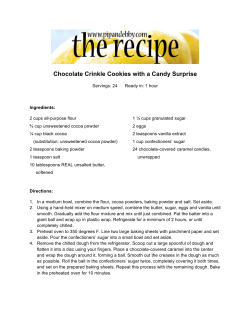
CARAMEL COLOURS AND 4-MEI: THE FACTS What are caramel colours?
CARAMEL COLOURS AND 4-MEI: THE FACTS What are caramel colours? th The process of caramellisation has been known since the early days of cooking. It was not until the 19 century, however, that caramel colour gained commercial significance, first as an additive in the brewery industry, and later, th th from the late 19 - early 20 century, in the soft drink industry, when a method for achieving acid stable caramel colour had been developed. Today caramel colour is manufactured using edible carbohydrates sources, which are heated and sometimes mixed with a liquid reactant (e.g. specified acids, alkalis and/or salts) under controlled temperature and pressure until a desired colour intensity is obtained, after which the caramel colour is cooled, filtered and stored until used in foodstuffs. The stability of caramel colours in different types of food can vary greatly, for instance depending on the acidity of the product to be coloured. That is why; currently there exist four classes of caramel colours, used according to their colour shade and stability in their final application. All four caramel colours have been approved as food additives under EU legislation with the E-numbers E 150 a, E 150 b, E 150 c and E 150 d. Caramel Colours are used in a wide range of food products, including but not limited to soft drinks, beer, spirits, bakery wares, cereals, sauces, gravies, soups, meats and spice blends, etc. Example of applications E150a E150b E150c E150d Spirits, baking wares and pet food Wine based products, liqueurs Beers, sauces, soups, baking wares and pet food Mainly soft drinks (cola’s) What is 4-MeI? Technically spoken, 4-MeI (4-methylimidazole) is a component that can be formed by interaction of nitrogen with reducing sugars, when a heat treatment process is applied. The reaction, in which this component is formed, is called the Maillard reaction, also known as the “browning reaction”. As such, whenever the above conditions are present in a food matrix, 4-MeI can be found in trace amounts in a wide variety of foods and beverages, such as roasted coffee, grilled meat, and baked goods. For caramel colours, the required conditions to form 4-MeI are met in the production of caramel colours E 150 c and d. The below table summarizes the ways of formation of 4-MeI in foods and caramels E 150 c and E 150 d. Note that these browning reaction products are also simply being formed while cooking, even in one’s very own kitchen. Result Composition Food in general Caramels Protein as nitrogen source + carbohydrates Added ammonium salts as nitrogen sources + carbohydrates Heat treatment process Examples “browning reaction” products like 4-MeI Bread, coffee, bakery wares, dark beers, home cooking. Barbecuing “browning reaction” products like 4-MeI E 150 c and E 150 d 1 What is exactly the concern with 4-MeI? In a study conducted by the National Toxicology Program (NTP) in the US, high doses of 4-MeI showed possible carcinogenic activity in mice. In another study conducted by NTP using rats, the compound did not appear to cause cancer and instead a significant reduction in 5 types of tumours was noted. In order for humans to be exposed to the amount of 4-MeI used in these mice studies, humans would have to consume totally unrealistic amounts of food (for instance 2900 cans of a cola beverage, per day, every single day of one’s life). Against the background of the above explanation, on how 4-MeI can be formed, it is also good to see the context of its presence in foods. Its presence can be due to the typical baking processes of food (example bread) and / or the use of caramels (beer, soft drinks, etc.). The below table gives a short overview: Products Concentrations 4-MeI (microgram / kg) (*) Bread Up to 5270 Coffee 390 – 1050 Soups 54 - 663 soft drinks 37 - 613 Spirits 1 - 531 Beer 3 - 202 Chocolate 11-35 (*) S.C. Cunha et. al. J. Food Comp & Anal. 2011 24(11) 1009-1011 (*) T. Shibamoto et.al. J. Ag & Food Chem. 2011 59(2) 615-618 1 When re-evaluating the safety of caramel colours as recently as March 2011 , the European Food Safety Authority (EFSA) concluded that “following a review of the scientific literature on 4-MeI including recent carcinogenicity studies in animals [including the NTP reports], the Panel considered that the highest exposure level to 4-MeI that could result from the consumption of foods containing E 150 c and E 150 d did not give rise to concern. (…) The maximum level established for 4-MeI in the specifications for these two caramel colours was therefore considered to be sufficiently protective”. The European Technical Caramel Association (EUTECA) has represented the Caramel Colour industry in the EU since 1985. Over the years, EUTECA’s mission is to improve general knowledge about Caramel Colour and its benefits, and to deliver factual information about Caramel Colours to European authorities and the general public. EUTECA is a member of the ELC, the Federation of European Specialty Food Ingredients Industries. EUTECA’s identification number in the Transparency Register is: 32106266349-71 For any further information, please contact: EUTECA secretariat Email: euteca@ecco-eu.com Phone: +32 2 736 53 54 Fax: +32 2 732 34 27 1 See EFSA’s Scientific Opinion on the re-evaluation of caramel colours (E 150 a,b,c,d) as food additives: http://www.efsa.europa.eu/en/efsajournal/doc/2004.pdf 2
© Copyright 2025
















